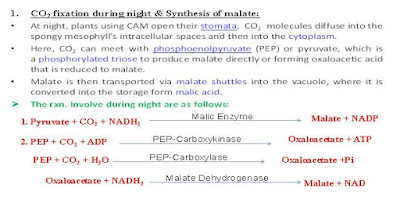CHAPTER: 10 (D)
Mechanism of Photosynthesis: The Dark Reaction
The dark rxn: (Backman’s Reaction)
• This second reaction of photosynthesis is independent of light, hence called dark reaction.
• The dark rxn utilizes ATP & NADPH2 molecules formed during light rxn for carbon fixation.
• It occurs in the stroma region of chloroplast.
• The CO2 absorbed by the plants from the environment combines with certain compounds to form intermediate compounds and ultimately leads to the formation of sugar and starch.
• Depending upon the initial product after CO2 fixation, three photosynthetic pathways were recognised in plants:
- Calvin Cycle(C3 cycle )
- Hatch and slack Cycle (C4 cycle)
- CAM (CAM plants)
Ø In C3 plants the first stable product after CO2 fixation is 3- C compound (Phosphoglyceric acid) and in C4 plants, 4- C compound (oxaloacetic acid) is the first stable product . In CAM cycle, the first stable product is malic acid.
Ø On the basis of different pathways for Dark rxn., plants are classified as;
1. C3 plants= follows C3 cycle i.e. Calvin Cycle during photosynthesis. Examples: Most of dicots , rice , wheat, barley,
2. C4 Plants = follows Hatch & Slack cycle during photosynthesis.
Examples: Most of monocots, maize , sugarcane.
3. CAM Plants = follows CAM pathway during photosynthesis.
Examples: Xerophytes plants.
- Calvin Cycle or C3 cycle:
Ø There are various steps involved in dark rxn of Calvin cycle. These are discussed on several headings as follows:
- Carboxylation:
• CO2 is first accepted by ribulose-1,5 diphosphate (RuDP) & forms an unstable 6-C compound.
• This 6-C compound immediately splits to form two molecules of phosphoglyceric acid (PGA).
• The rxn takes place in the presence of enzyme RuDP Carboxylase (Rubisco).
RuDP Carboxylase
RuDP + CO2 + H2O =========> 2PGA
- Hatch and slack Cycle (C4 cycle):
• M.D. Hatch and C.R. Slack (1967) gave a new process of CO2 fixation.
• This cycle takes place mostly in monocots plants (Sugarcane, maize, Cyprus) and in some dicots (Amaranthus).
• Plant in which CO2fixation takes place by Calvin cycle only are called C3plants (because first products of CO2 fixation is a 3 carbon containing compound, Phosphoglyceric acid). But in Hatch –Slack Pathway , first product of CO2 fixation is a 4 carbon containing compound, Oxaloacetic acid , hence these plants are called C4 –Plants and the cycle of photosynthesis is known as C4 - Cycle.
Anatomical Features of Leaves of C4 –Plants:
• Anatomically, the C4 –Plants are characterized by the presence of bundle sheath cells around the vascular bundles.
• This type of arrangement is called Kranz Anatomy.
• In the mesophyll of leaves of these plants, pallisade tissue is absent.
• Typically C4 –Plants possess two types of chloroplasts. One type in kranz-sheath, which is large and lack grana but contains enzymes of calvin cycle(C3 –Cycle). Another type of chloroplast is found in mesophyll cells, which are smaller with well developed grana and contains enzymes for C4– Cycle.
- CAM Cycle (CAM plants):
• Crassulacean acid metabolism, also known as CAM photosynthesis, is a carbon fixation pathway that evolved in some plants as an adaptation to arid conditions.
• In a plant using full CAM, the stomata in the leaves remain shut during the day to reduce evapotranspiration, but open at night to collect carbondioxide(CO2).
• The CO2 is stored as the four-carbon acid malate, and then used during photosynthesis during the day.
• The pre-collected CO2 is concentrated around the enzyme RuBisCO, increasing photosynthetic efficiency.
Ø The CAM cycle can be divided into two parts:
1. CO2 fixation during night & Synthesis of malate
2. Utilization of Malate during day and release of CO2
Ø The CO2 thus produced in either of the above two ways is then consumed in normal photosynthetic reaction to yield carbohydrates.
Ø Pyruvate and PEP are also utilized for carbohydrates synthesis during the day. Pyruvate is first converted into PEP in the presence of enzyme pyruvate orthophosphate dikinase.
Ø PEP is then converted into 3PGA by reverse reaction of glycolysis. Thereafter 3PGA is utilized in the calvin cycle.















Post A Comment:
0 comments: